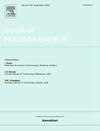基于改进运动窗和稀疏自编码器的核电厂故障检测
IF 2.3
3区 工程技术
Q1 NUCLEAR SCIENCE & TECHNOLOGY
引用次数: 0
摘要
由于部件性能退化和运行工况变化等因素,核电站设备在运行过程中表现出明显的时变特征,导致故障检测模型失效。因此,本研究提出了一种基于改进的移动窗和稀疏自编码器的故障检测方法,以增强检测方法对核电厂时变数据的适应性。该方法建立稀疏自编码器作为故障检测模型,通过计算测试数据与重构数据之间的统计关系来确定设备的运行状态。在此过程中,对传统的基于欧氏距离的移动窗口更新策略进行了优化,改进的移动窗口策略实现了有效的模型更新。最后,用某核电站反应堆冷却剂泵的实测数据验证了该方法的有效性。结果表明,该方法在故障检测率和虚警率方面都有较好的效果。本文章由计算机程序翻译,如有差异,请以英文原文为准。
Fault detection for nuclear power plant based on improved moving window and sparse autoencoder
Due to factors such as component performance degradation and changes in operating conditions, nuclear power plants (NPPs) equipment exhibits significant time-varying characteristics during operation, leading to the failure of fault detection models. Therefore, this study proposes a fault detection method based on an improved moving window and sparse autoencoder to enhance the adaptability of the detection method to the time-varying data of NPPs. This method establishes a sparse autoencoder as a fault detection model, determining the operating status of equipment by calculating the statistical relationship between test data and reconstructed data. In this process, the traditional moving window update strategy is optimized based on Euclidean distance, and the improved moving window strategy enables effective model updating. Finally, the effectiveness of the proposed method is verified using data from a nuclear power plant reactor coolant pump. The results show that the proposed method performs well in terms of fault detection rate and false alarm rate.
求助全文
通过发布文献求助,成功后即可免费获取论文全文。
去求助
来源期刊

Annals of Nuclear Energy
工程技术-核科学技术
CiteScore
4.30
自引率
21.10%
发文量
632
审稿时长
7.3 months
期刊介绍:
Annals of Nuclear Energy provides an international medium for the communication of original research, ideas and developments in all areas of the field of nuclear energy science and technology. Its scope embraces nuclear fuel reserves, fuel cycles and cost, materials, processing, system and component technology (fission only), design and optimization, direct conversion of nuclear energy sources, environmental control, reactor physics, heat transfer and fluid dynamics, structural analysis, fuel management, future developments, nuclear fuel and safety, nuclear aerosol, neutron physics, computer technology (both software and hardware), risk assessment, radioactive waste disposal and reactor thermal hydraulics. Papers submitted to Annals need to demonstrate a clear link to nuclear power generation/nuclear engineering. Papers which deal with pure nuclear physics, pure health physics, imaging, or attenuation and shielding properties of concretes and various geological materials are not within the scope of the journal. Also, papers that deal with policy or economics are not within the scope of the journal.
 求助内容:
求助内容: 应助结果提醒方式:
应助结果提醒方式:


